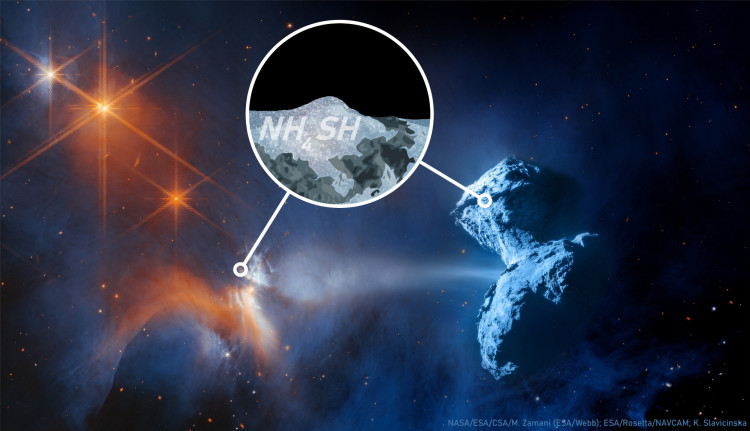For the past two decades, astrochemists and astronomers have been puzzled by two seemingly inexplicable mysteries. The first was that the amount of volatile sulfur in dense clouds and star-forming regions is much lower than in the more tenuous regions between stars. The sulfur seemed to be disappearing. The second was that the spectrum of infrared light from star-forming regions contains a striking but unexplained peak.
An international team led by researchers from Leiden University in the Netherlands proposes a solution to both mysteries at once: ammonium hydrosulfide salt. The researchers support their solution with laboratory experiments that simulate cosmic conditions. These involve extremely cold conditions in which dust, ice and pebbles are present, and relatively few molecules can react.
The experiments showed that volatile NH3 (ammonia, well-known from detergents) and volatile H2S (hydrogen sulfide, the smell of rotten eggs) react rapidly to form NH4SH (ammonium hydrosulfide salt) when they join in ices around dust particles. This suggests that in dense star-forming regions some of the volatile sulfur is trapped on dust and pebbles. As a result, the sulfur seems to have disappeared.
In addition, the experiments showed that the ammonium hydrosulfide salt produces a peak at the exact location of the previously unexplained peak in data from, among others, the MIRI instrument on the James Webb Space Telescope. This peak allowed the astronomers to calculate that up to approximately 20 per cent of the missing sulfur could be in the form of this sulfur salt on dust and pebbles.
Two birds with one stone
“I think it is great that we are finally unravelling both mysteries”, says Katie Slavicinska. She is a PhD student at Leiden University and first author of the scientific paper. “With our research, we are killing two birds with one stone.”
The research was triggered by results from ESA's Rosetta mission. During this mission, a spacecraft orbited comet 67P between 2014 and 2016. Analyses published in late 2022 showed that the comet's dust particles contained unexpectedly high levels of ammonium hydrosulfide. Slavicinska: "And since we suspect that comets contain a lot of pristine icy material from the early days of our solar system, looking for ammonium hydrosulfide in the ice of star-forming regions was the logical next step.
Second author Adwin Boogert, a Dutch scientist working at the University of Hawaii at Manoa says: "It's exciting to see how we can increasingly follow chemical traces back from our current solar system to the origin of new solar systems."
In the future, the researchers plan to make more observations with the MIRI instrument on the James Webb Space Telescope to confirm the theory of the infrared peak. They also hope to find the remaining eighty percent of the missing sulfur. Previous research suggests that metallic sulfides and sulfur allotropes could play a role.
Scientific paper
Ammonium hydrosulfide (NH4SH) as a potentially significant sulfur sink in interstellar ices. By: K. Slavicinska, A.C.A. Boogert, Ł. Tychoniec, E.F. van Dishoeck, M.L. van Gelder, M.G. Navarro, J.C. Santos, P.D. Klaassen, P.J. Kavanagh & K.-J. Chuang. In: Astronomy & Astrophysics. [original (open access) | preprint]
 Composite image of a star-forming region (left) and Comet 67P (right). In the center is the ammonium hydrosulfide salt (NH4SH) that both appear to have in common, and which explains, among other things, why there is less volatile sulfur in star-forming regions than expected. (c) NASA/ESA/CSA/M. Zamani (ESA/Webb); ESA/Rosetta/NAVCAM; K. Slavicinska. [high resolution]
Composite image of a star-forming region (left) and Comet 67P (right). In the center is the ammonium hydrosulfide salt (NH4SH) that both appear to have in common, and which explains, among other things, why there is less volatile sulfur in star-forming regions than expected. (c) NASA/ESA/CSA/M. Zamani (ESA/Webb); ESA/Rosetta/NAVCAM; K. Slavicinska. [high resolution]
